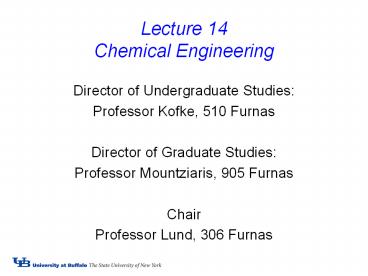Lecture 14 Chemical Engineering - PowerPoint PPT Presentation
Title:
Lecture 14 Chemical Engineering
Description:
Lecture 14 Chemical Engineering – PowerPoint PPT presentation
Number of Views:4005
Avg rating:3.0/5.0
Title: Lecture 14 Chemical Engineering
1
Lecture 14Chemical Engineering
- Director of Undergraduate Studies
- Professor Kofke, 510 Furnas
- Director of Graduate Studies
- Professor Mountziaris, 905 Furnas
- Chair
- Professor Lund, 306 Furnas
2
Looking Back to the Turn of the Last Century...
- Fear that soon it would not be possible to feed
all the people in the world. - Chemical Engineers solved the problem
- Haber (1918 Nobel Prize)/Bosch (1931 Nobel Prize)
- Process for synthesis of ammonia
- 350 to 500 ºC 1.1 Tons/in2
- And now at the turn of the 20th century
- Global warming
- Protection of the environment
- Depletion of natural resources (synthetic fuels)
3
Ammonia Synthesis Plant
4
Jobs CEs Do
- Flow (pump/compressor size, pipe size, pressure
drops through equipment) - Reactor Design/ Reaction Engineering
- Heating, Cooling, Refrigeration, Heat Transfer
- Materials (polymers, metals, ceramics, catalysts)
synthesis and/or selection - Separation (reactants, final products) by many
methods (distillation, absorption, adsorption,
crystallization, etc.)
5
Jobs CEs Do
- Plant Design / Process Optimization
- Safety
- Plant Operation
- Environmental / Waste Treatment
- Sales, Marketing, Distribution
- Law, Medicine, Management
- Education
6
Tools CEs Use
- Mathematics (algebra, calculus, differential
equations, numerical methods) - Chemistry (inorganic, organic, physical)
- Mass, Energy and Momentum Balances
- Thermodynamics and Kinetics
- Transport Phenomena / Transfer Operations
- Unit Operations
- Process Control Optimization
- Process Simulators
- Modeling and Computation
7
Chemical Engineering Facts
- U.S. Initial Placement of CEs, 1998
- Industry 57.2
- Government 2.2
- Graduate School 14.4
- Returned Overseas 1.7
- Unemployed 6.6
- Other 4.2
- Unknown 13.6
8
Industries that Employ CEs
- Petroleum, petrochemical, chemical
- Plastics / polymers
- Pharmaceutical
- Fine and high performance chemicals
- Food
- Microelectronics
- Biotechnology
- Automobile
- Education and Professional
9
Industry Employment 1998
- Chemical 26.1
- Fuels 10.8
- Electronics 11.4
- Food/Consumer Products 14.6
- Design Construction 7.2
- Materials 6.0
- Biotechnology (Pharmaceuticals) 4.6
- Environmental 2.6
- Pulp Paper 2.9
- Public Utilities 0.8
- Other Industries 13
10
The CE CurriculumFreshmen
- Fall
- Calculus I
- Chemistry
- Eng. Solutions
- General Education (2)
- Spring
- Calculus II
- Physics I
- Chemistry II
- General Education (2)
11
The CE CurriculumSophomore
- Fall
- Calculus III
- Physics II
- Engineering Thermo
- CE 212 (Mass Energy Balances)
- General Education
- Spring
- Differential Equations
- Statics
- CE Thermo
- EAS 230
- Technical Elective (Communications)
12
The CE CurriculumJunior
- Fall
- Organic Chemistry I
- CE Design
- Transport Processes I
- CE laboratory I
- General education
- Spring
- Organic Chemistry II
- Physical Chemistry lab
- CE Unit Operations I
- Transport Processes II
- CE laboratory II
- General education
13
The CE CurriculumSenior
- Fall
- CE Unit Operations II
- CE Reaction Engineering
- Material Science Corrosion
- CE laboratory III
- CE Technical Elective
- General education
- Spring
- CE Plant Design
- CE laboratory IV
- CE Technical Elective
- Technical Elective
- Engineering Elective
14
CE Electives (Courses)
- Rheology of fluids
- Introduction to polymers
- Engineering and process economics
- Process analysis and synthesis
- Process control
- Biochemical engineering
- Colloid and surface phenomena
- Frontiers of chemical technology
15
CE Electives Programs
- Internship, ECI, Co-op
- Independent Study
- NSF REU in Environmentally Benign Processing
- BS/MEng dual degree program
- BS/MBA program
16
CE Program Quality
- Student AIChE Chem-E Car Team
- First and Second Places in Northeast
- Compete at nationals in November
- Last year, 3rd at nationals in environmental
design competition - Most SUNY Chancellors Award Winners in EAS
- 4 of 8 tenured professors
- Nationally ranked 29th
- out of 93 that were ranked and 161 total
- Only CE in SUNY
17
CE Faculty Quality
- AIChE Directory lists 161 Chem. Eng. Depts. ours
is ranked 29th in most recent NRC - NRC Ranking is 13th on per faculty basis (Chem.
Eng. Ed. 33, 72, 1999) - 10th in the world in publication records of
Chem. Eng. Depts Korean Advanced Institute of
Science and Technology - 7th in the U.S. in citation impact Institute for
Scientific Information (University Science
Indicators) - Externally Supported Research (1999-2000FY)1,224
,136
- U.S. Medal of Science winner
- National Academy of Engineering member
- National Society Awards
- 7 National Science Foundation (NSF) Young
Investigator Awards (PYI, etc.), R. H. Wilhelm
Award (AIChE), Alpha Chi Sigma Award (AIChE),
National Science Foundation Creativity Award,
Kendall Award (ACS), Walker Award (AIChE),
Norman Hackerman Award in Solid State Science and
Technology (Electrochemical Society), Langmuir
Distinguished Lecturer Award (ACS), E. V.
Murphree Award in Industrial Engineering
Chemistry (ACS), ATT Foundation Award (ASEE),, 2
National Institute of Health (NIH) First Awards,
3 Dow Outstanding New Faculty Award (ASEE), Cray
Research Award for Supercomputing Applications, 7
SUNY Chancellors Awards for Teaching Excellence

